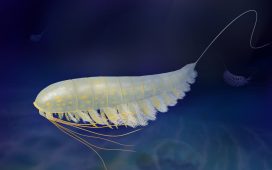A deep-sea expedition off the coast of Chile has uncovered a treasure trove of scientific wonders, including more than 100 previously unknown marine species and a handful of never-before-seen underwater mountains — the largest of which is around four times the size of the world’s tallest building.
Incredible photos and video footage of the underwater landscape also showcase a menagerie of deep-sea weirdos, including intricate sponges, spiraling corals, a beady-eye lobster, a bizarre stack of oblong sea urchins and a bright red “sea toad” with hands for fins.
Between Jan. 8 and Feb. 11, researchers on board the Schmidt Ocean Institute’s (SOI) research vessel Falkor (too) explored the seafloor off the coast of Chile. The expedition, named “Seamounts of the Southeast Pacific,” focused on underwater mountains, or seamounts, in three main areas: the Nazca and Salas y Gómez ridges — two chains of more than 200 seamounts that stretch a combined 1,800 miles (2,900 kilometers) from Chile to Easter Island (also known as Rapa Nui); as well as the Juan Fernández and Nazca-Desventuradas marine parks.
In total, the researchers mapped around 20,400 square miles (52,800 square kilometers) of ocean.
These new, highly detailed maps revealed four previously unknown solitary seamounts. The biggest of these, which the team dubbed Solito — meaning “alone” in Spanish — towers 11,581 feet (3,530 meters) above the seafloor, making it more than four times taller than the world’s tallest building, the Burj Khalifa, which stands at 2,716 feet (828 m) tall.
Related: 10 mind-boggling deep sea discoveries in 2023
The research team also used an underwater robot to explore the submerged slopes of 10 seamounts across the study range. This revealed more than 100 species that the scientists suspect are new to science, including corals, sponges, sea urchins, mollusks and crustaceans.
“We far exceeded our hopes on this expedition,” Javier Sellanes, a marine biologist at the Catholic University of the North, in Chile, and lead scientist on the expedition, said in a statement emailed to Live Science. “You always expect to find new species in these remote and poorly explored areas, but the amount we found, especially for some groups like sponges, is mind-blowing.”
The researchers took samples of the creatures and will now begin studying each one to determine whether it is a newfound species.
“Full species identification can take many years,” Jyotika Virmani, SOI’s executive director, said in the statement. And the “incredible number of samples” could make this process even longer, she added.
The researchers noted that a majority of the species live within vulnerable habitats, such as cold-water corals and sponge gardens, which are highly susceptible to damage from trawling and deep-sea mining. The new species within the Juan Fernández and Nazca-Desventuradas parks are legally protected from these threats. However, the seamounts along the Nazca and Salas y Gómez ridges are currently unprotected.
This research trip is the latest of several SOI expeditions that have mapped seamounts in the southeast Pacific in recent years.
The institute previously mapped four other massive seamounts during an expedition off the coast of Chile and Peru, as well as another solitary peak off the coast of Guatemala last year. Each of these five peaks was at least twice as tall as the Burj Khalifa.
It is important to find and study these towering “biological hotspots” because they can “advance our knowledge of life on Earth,” Virmani previously said after the discovery of the seamounts in Chile and Peru.











